Zortrax Endureal: The New Industrial 3D Printer for High-Temp Polymers
Advanced manufacturing with high-performance filaments is now possible in the Zortrax Ecosystem due to the Zortrax Endureal, our newly introduced industrial third-generation 3D printer. Division into generations of 3D devices has been made on the basis of their design and specificity of operation. The first-generation 3D printers relied on room temperature performance. The second-generation machines, like the Zortrax Inventure, introduced enclosed printing chambers that could be heated to around 80° C. The third-generation 3D printers, which are currently entering the market, offers advanced thermal management capabilities where a user can precisely define printing chamber temperature all the way up to 200° C. Manuel Garcia-Leiner, one of the 3D printing industry thought leaders, proposed dividing 3D printers down into these three generations back in 2019 and it perfectly matches the Zortrax Ecosystem, including the newly developed Endureal. This industrial-grade device has been designed to print with the strongest polymers on the planet in an advanced thermal management system. Here’s how it works.
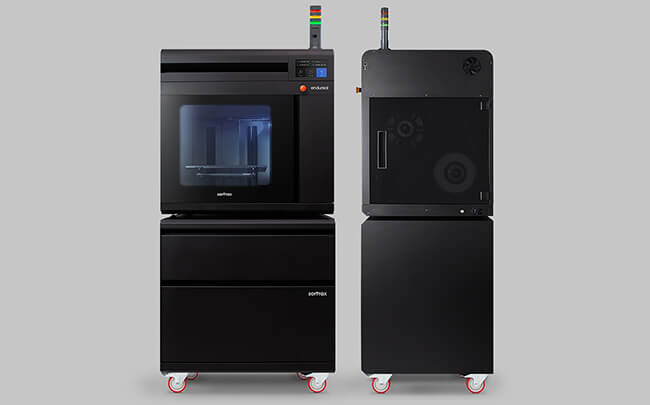
Thermal Management Solutions
As the machine is aimed at the industrial sector, the Endureal has been made to print with high-temperature Z-PEI 9085 or PEEK-based polymers that offer excellent properties comparable to metal alloys, but have lower density and weight. 3D printing with such materials requires a seamless operation of device’s components as well as creating conditions that frequently involve very high temperatures. We have ensured that the printer operates at up to 480° C required for material extrusion and can maintain stable 200° C in the printing chamber which is more than enough for even the most demanding high-temp filaments. Therefore, building a machine that would withstand such printing process settings was quite a challenge. Our engineers had to meticulously select the materials and components for the printer’s hardware as well as thoroughly consider the principles guiding the processes it would perform. For that reason, the Endureal has been designed around three thermally isolated zones: the printing chamber, the extruder’s compartment, and the filaments compartment. With the advanced technological solutions, the temperature maintained in one of these zones have a minimal impact on the other two. The difference in temperatures between the chamber and the extruder’s compartment may reach more than 100° C. Additionally, we’ve managed to allow users to precisely adjust temperatures in the three key points during the printing process, namely in the extruder, on the build platform, and in the printing chamber to achieve the best possible performance in printing high-temp polymers.
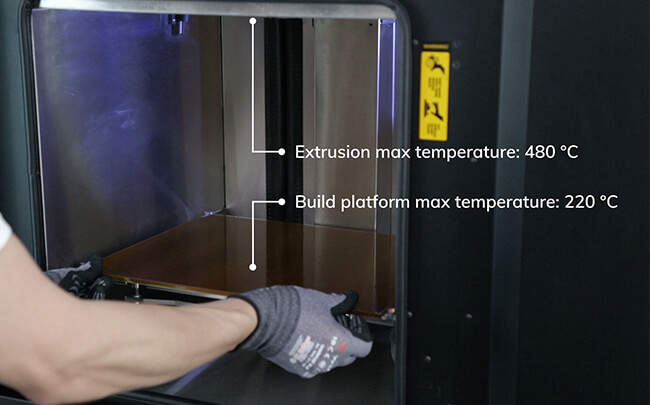
Performance under Control
The Endureal maintains full control over every stage of building the model as well as the condition of hardware components. The printer is equipped with an array of sensors which enable real-time monitoring of extrusion and operation of crucial parts. The Blackout Response System, already proven in our M Series Plus and M300 Dual 3D printers, is there to save the printing progress when it detects a power outage. The Endureal can recover the exact position of the extruder and continue to print from the same spot. At all times, users can monitor the printing progress by checking a live footage from the heat-resistant camera installed in the printing chamber. Multiple separate sensors are responsible for detecting issues with filaments, so the user will always be notified when the filament has jammed or simply run out. Seamless operation is also ensured by temperature sensors which prevent overheating of the printer, as well as capacitive and optical sensors which measure precise position of hardware components. In addition, the filaments’ compartment creates a closed environment with the most optimal temperature and reduced humidity levels that are suitable for storage of highly hygroscopic materials. All these safety measures have been incorporated in the Endureal’s design to ensure uninterrupted and efficient printing with filaments that require technologically advanced processing.
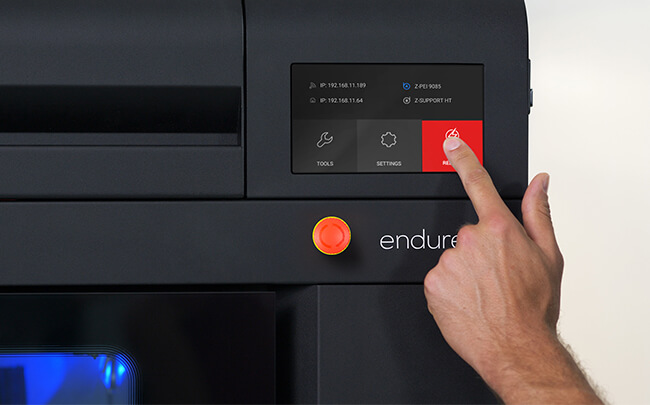
Comprehensive Processes for High-Temp Materials
When processing high-temp materials in the Zortrax Endureal, it is required to carry out certain pre- and post-printing treatment. Apart from the printing process which has to take place with adequate thermal parameters, we’ve narrowed down the material treatment to two steps that help to achieve the desired printing results and final properties of models. The first one is filament drying. It should be performed before the printing to reduce the amount of moisture in the material which, if not removed, could have an adverse impact on the printed model’s thermal and mechanical properties. Similarly, finished prints have to undergo a controlled process called “annealing,” during which they are heated to their glass transition temperature (below the melting point), kept in this temperature for some time, and then slowly cooled down. Annealing dissipates stresses accumulated within models during the printing process, and significantly improves physical and mechanical properties without changing their initial shape. Both these procedures are performed in the Endureal’s main chamber and have dedicated options in the menu. The solutions introduced in this industrial 3D printer have made processing of demanding filaments as easy as working with standard ABS or PLA. With very little effort needed for material treatment, users can simply start the printing, and after some time, remove supports from the printed model.
Supports in Dual-Extrusion
Since we wanted the Endureal to process filaments with exceptional strength and increased mechanical properties, we knew that printing support structures needed a well-thought-out solution. The printer simply could not use the same material for both models and supports. It would generate unnecessary costs and make the model post-processing difficult. Therefore, the Endureal’s design included a dual-extrusion system from the very beginning, as it allows users to print support structures that are appropriate for the used model material.
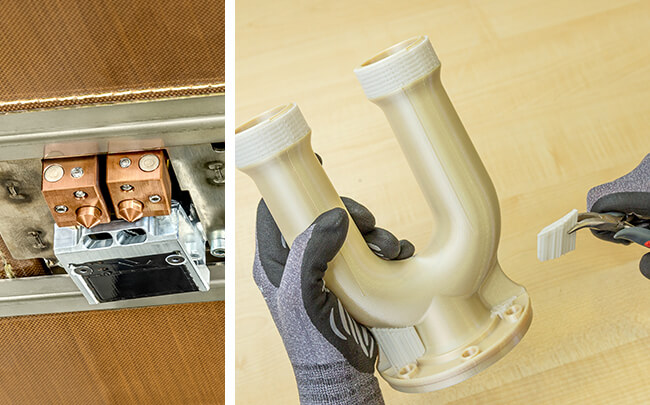
We have thoroughly tested both breakaway and soluble materials that are designed to facilitate 3D printing with all types of supported polymers. These support materials can withstand high temperatures and provide appropriate stability to models. Moreover, adhesion during the printing process is further improved thanks to the aluminum build platform covered with a PEI film. The platform maintains very good mechanical properties at a wide range of temperatures reaching even 220° C. The strong link between specialized polymers and dual-extrusion machines will continue to grow and exceed our expectations in the future. We might be able to use two different high-performance materials simultaneously to print advanced composite parts with properties matching specific needs. Such technologies are currently being developed for the European Space Agency.
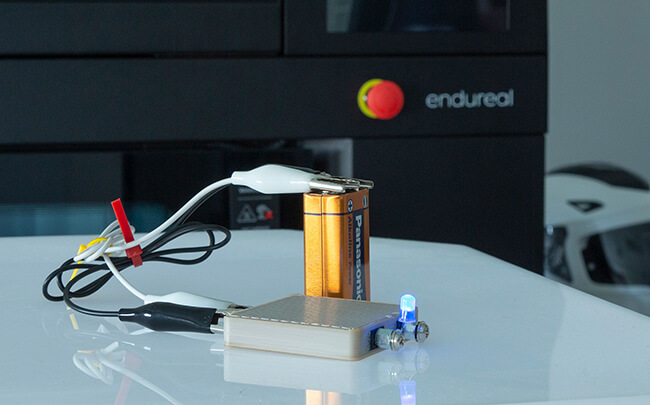
Multiple Industrial Applications
Z-PEI 9085 is one of the high-temp 3D printing materials Zortrax Endureal is compatible with. This polymer has a proven track record in the aerospace industry where it is used by world-leading manufacturers for printing flame-retardant aircraft interior components. It has thermal and mechanical properties comparable to aluminum 6061. Recent developments have also pointed at a strong potential to use this material in space industry as well. A cubesat structural frame made of the same blend of polyetherimide we use in Z-PEI 9085 has successfully passed vibration tests necessary for spaceflight clearance. Z-PEI 9085 is also one of the few 3D printing materials that has been cleared for use onboard the International Space Station due to its low FST (Flame, Smoke, Toxicity) and good performance in outgassing tests.
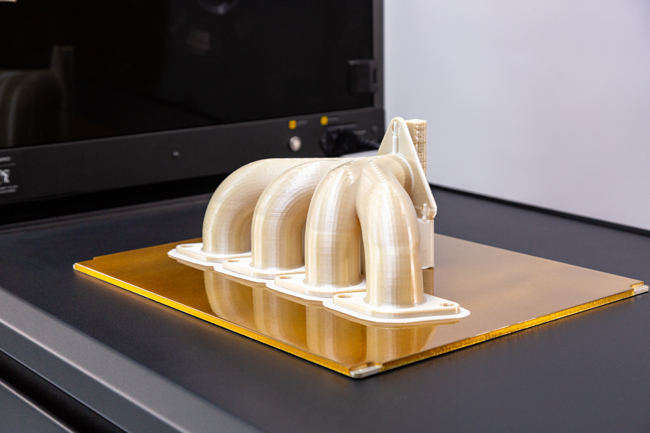
Another material the space industry has already tested is PEEK. Components made with this polymer have been tested in various conditions, exposure to low Earth orbit environment outside of the International Space Station included. The samples showed minimal degradation in vacuum or when exposed to radiation and extreme temperature changes. That’s why the researchers could adapt PEEK-printed structural parts with very good properties in terms of strength, stability and temperature resistance in their work. PEEK materials are also biocompatible which opens up a possibility to 3D print fully-functional, implantable medical devices.
The Zortrax Endureal is an innovative machine which perfectly suits all of the above-mentioned industries and fields. It can perform all essential procedures required for processing high-performance filaments from drying and printing to annealing, and ensures ease of use and versatility. Most importantly, users in most cases can perform maintenance and servicing on their own without voiding the warranty, which significantly minimizes downtime as there’s no need to wait for qualified service technicians. Thus, it’s a unique solution precisely tailored to the needs of high-tech industries.